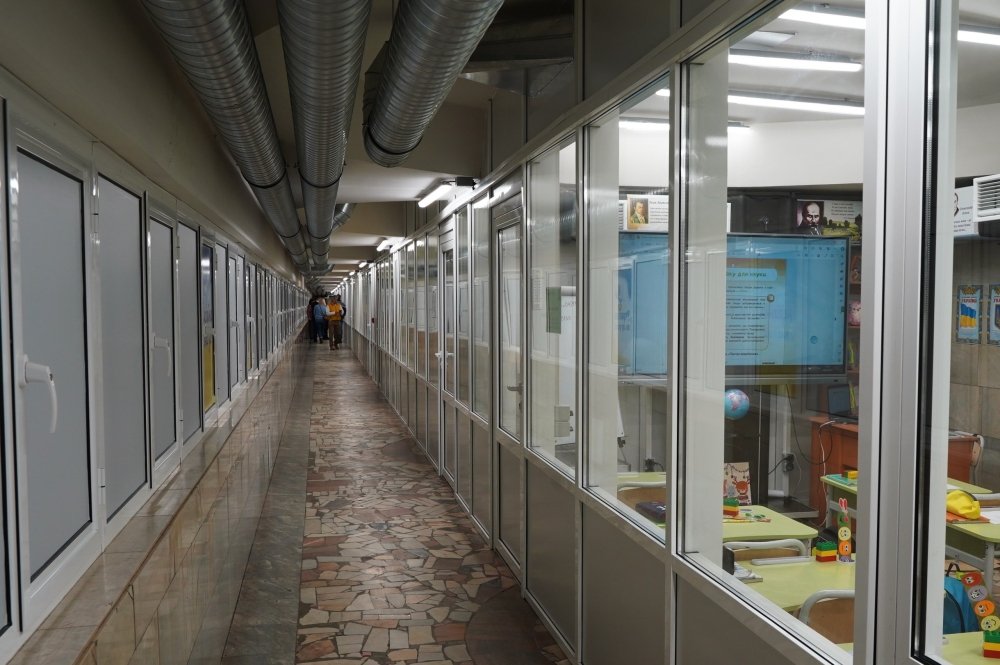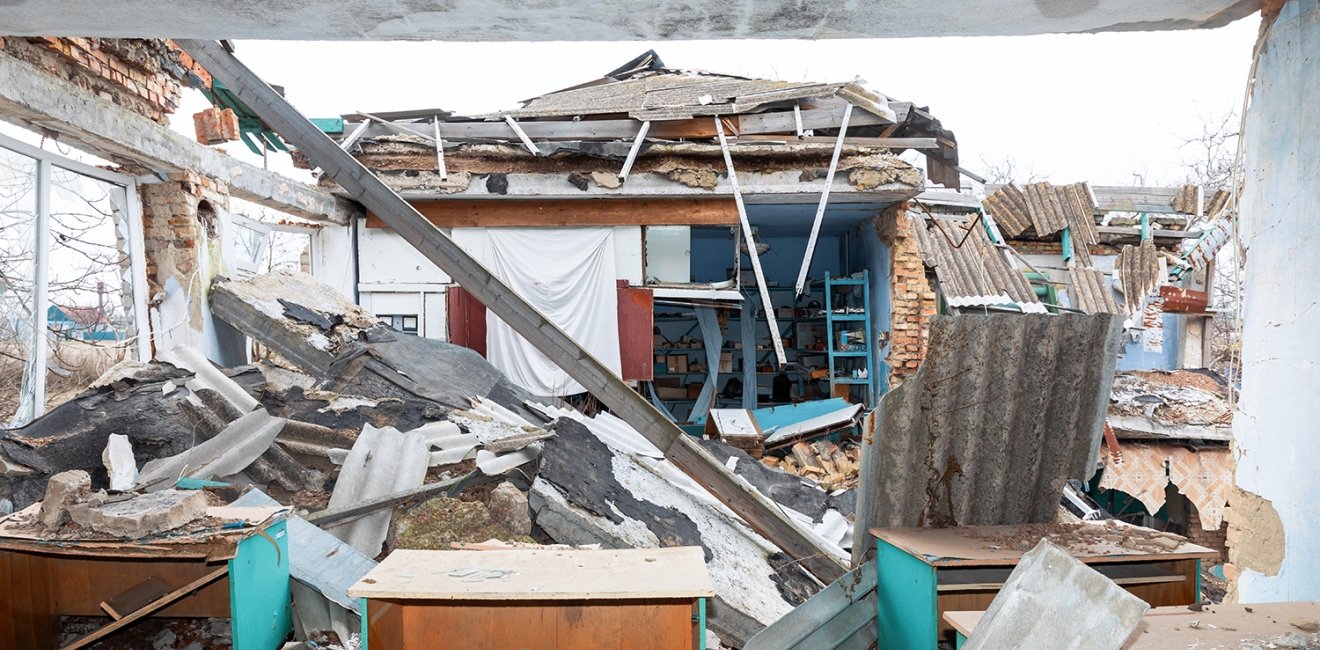
A blog of the Wilson Center
Since Putin launched his full-scale invasion in February 2022, Russian forces have destroyed one of every seven schools in Ukraine.
There’s little subtlety in Vladimir Putin’s approach to his war in Ukraine. Over the first two years of its full-scale invasion, Russia launched more than 8,000 missiles, 4,600 drone attacks, and countless shellings. In an attempt to bludgeon Ukraine into submission, Russian forces have destroyed more than 210,000 buildings and inflicted more than $1 billion in damage to the country’s energy infrastructure. The United Nations Refugee Agency estimates that these attacks have forced nearly one-third of the population to flee their homes and created nearly 6.5 million refugees and 3.7 million internally displaced persons.
Ukraine’s education system has been especially hard hit by Russian forces. According to Ukraine’s Deputy Minister of Education, they have struck more than 3,500 educational facilities, destroying 1 out of every 7 schools through the first 2 ½ years of fighting. According to UNICEF, these attacks have left more than 5 million Ukrainian children with only restricted access to traditional schooling and nearly 1.9 million largely dependent on remote learning.
An obvious reason for the Kremlin’s emphasis on damaging or destroying Ukrainian schools is that it serves his broader purpose of inflicting as much pain as possible on the daily lives of Ukrainian families. His forces regularly go after apartment buildings, hospitals, sports facilities…and schools—facilities with no military value, but whose damage and destruction affect the public’s psyche and emotional wellbeing.
But Ukrainian officials believe there’s much more to what the Kremlin is doing. They say Putin wants to disrupt education and learning in Ukraine because it serves another of his top priorities: the long-term “Russification” of Ukraine. Russia wants to dismantle, erase, and replace all aspects of Ukrainian daily life that reinforce Ukraine’s cultural identity separate from merely being part of “greater Russia.” It wouldn’t be the first time either—Putin is continuing a longstanding pattern of “Russification,” most notably seen when Stalin forcibly deported the Crimean Tatar population.
Putin and his closest followers have long claimed that there is no Ukraine…at least not as a sovereign nation. In a 2021 essay, for example, Putin wrote that “Russians and Ukrainians were one people—a single whole,” with a shared ethnic origin going back to the 9th century. In an effort to erase any evidence that conflicts with that claim, Russian forces have destroyed more than 2,000 cultural objects since the full-scale invasion began, and have damaged nearly 500 culturally important sites, from historic buildings to museums and churches. Ukrainian officials claim that Russia has removed over 15,000 artifacts from Kherson alone.
The seizure of cultural objects is not merely the “collateral damage” of war. Author Jade McGlynn points out in Russia’s War that not long after the full-scale invasion began, the Kremlin took steps to legitimize and approve the seizure of Ukrainian artifacts as a matter of official policy. Then, where Russian forces captured and occupied Ukrainian territory, they established “museums” with propagandized exhibits supporting claims of Russian sovereignty over Ukrainian soil. They also renamed various streets and facilities to reflect Soviet-era nomenclature and control.
The Kremlin has even been careful with the terminology it uses to describe its battlefield tactics and strategy. Moscow doesn’t characterize its invasion as a war—that could imply that Ukraine is a separate state. Instead, the attacks are a “special operation” to “demilitarize and denazify” Ukrainian territory. Pointing out that Ukraine’s leaders have all been democratically elected, officials in Kyiv say “demilitarize and denazify” is simply a euphemism for a determined effort to destroy Ukraine as a separate country and culture.
Ukrainian officials say the real reason Russian forces go after educational facilities is because education is how culture, history, and civic identity are reinforced and passed on from one generation to the next. By destroying schools, they say that the Kremlin wants to destroy the socialization and cultural experience that comes with in-person lessons and activities. By forcibly displacing Ukrainian families and forcing many to flee into neighboring countries, Russia is trying to weaken their daily connection to Ukrainian traditions and practices. By reprogramming educational materials and curricula to reflect propagandized Russian culture and mythology, Putin aims to gradually erase Ukrainian culture from the collective memory of Ukrainian youth.
In territory that Russian forces occupy, they’ve essentially turned education into a weapon of war. Ukrainian books are removed from schools and libraries, while new mobile libraries distribute Russian educational resources. New curricula are enforced that center around Russian language and history (with a special emphasis on Russia’s military achievements). Lessons are taught by teachers brought in from Russia when Ukrainian educators refuse to cooperate. New cadet schools and Russian youth organizations work to prepare Ukrainian children to fight alongside Russians in future conflicts.
But just as Ukrainians have been resilient and adaptive on the battlefield, they have been so in learning and teaching—and keeping Ukrainian culture alive. In classroom terms, they have created makeshift classrooms where Russian missiles and artillery have rendered traditional schools unusable. When I visited Kharkiv earlier this year as part of a journey around the country with the UN’s Refugee Agency, I observed kids learning in classrooms established in underground subway stations. Tight quarters, of course, but there were teachers and students, books and desks, and student artwork on the walls. The underground facilities were also being used outside of the school day for poetry readings, concerts, and holiday festivities.

For students and families that have fled their homes for other parts of the country, remote learning is being supplemented by radio, television, and online messaging from President Zelensky and others, reaffirming their confidence that students will be able to return home one day…and reunite with friends and neighbors.
For those who have been forced to relocate to other countries—places like Poland, Moldova, and Germany—Ukrainian officials and education advocates have gone even further to strengthen the bonds between students and the country they’ve left behind. They’ve created appealing interactive games which offer participants entertaining lessons on Ukrainian life, culture, and history. One example is “We Are Ukraine,” a game where players “travel across Ukraine” by train, and explore the “country’s iconic cities and cultural heritage” in an effort to “keep the Ukrainian spirit alive.” Children using the game’s platform can also chat and connect with each other, helping students to maintain connections with friends near and far. Ukraine’s Ministry of Digital Transformation has also worked to develop an in-depth “school offline” policy, working to reshape education policies that enhance the remote learning format and allow thousands of children to return to in person learning.
Vladimir Putin wants to demoralize everyday Ukrainians, and so he singles out civilian targets which have the greatest emotional value for them. Ukrainians are fighting back with displays of their art and culture amidst the rubble. He seeks to destroy Ukrainian cultural symbols and replace them with country’s traditions with propagandized Russian messages that push his claim that Ukraine doesn’t exist, apart from being a piece of greater Russia. He aims to block and disrupt any efforts to hand Ukraine’s cultural identity to the next generation which has resulted in “cultural genocide.”
But just as Ukrainians have proven their mettle, adaptability, and resilience on the battlefield, they’re innovating to make sure that their country’s heritage and identity continue. They believe that their culture—what makes them Ukrainian, not Moldovan, nor Georgian, nor most of all, Russian—is their true “superpower.”
This blog was researched and drafted with assistance from Chelsea Acheampong.
Author


Global Europe Program
The Global Europe Program is focused on Europe’s capabilities, and how it engages on critical global issues. We investigate European approaches to critical global issues. We examine Europe’s relations with Russia and Eurasia, China and the Indo-Pacific, the Middle East and Africa. Our initiatives include “Ukraine in Europe”—an examination of what it will take to make Ukraine’s European future a reality. But we also examine the role of NATO, the European Union and the OSCE, Europe’s energy security, transatlantic trade disputes, and challenges to democracy. The Global Europe Program’s staff, scholars-in-residence, and Global Fellows participate in seminars, policy study groups, and international conferences to provide analytical recommendations to policy makers and the media. Read more


Kennan Institute
The Kennan Institute is the premier US center for advanced research on Eurasia and the oldest and largest regional program at the Woodrow Wilson International Center for Scholars. The Kennan Institute is committed to improving American understanding of Russia, Ukraine, Central Asia, the South Caucasus, and the surrounding region through research and exchange. Read more

Explore More in Stubborn Things
Browse Stubborn Things
Spying on Poachers

China and the Chocolate Factory

India: Economic Growth, Environmental Realities

